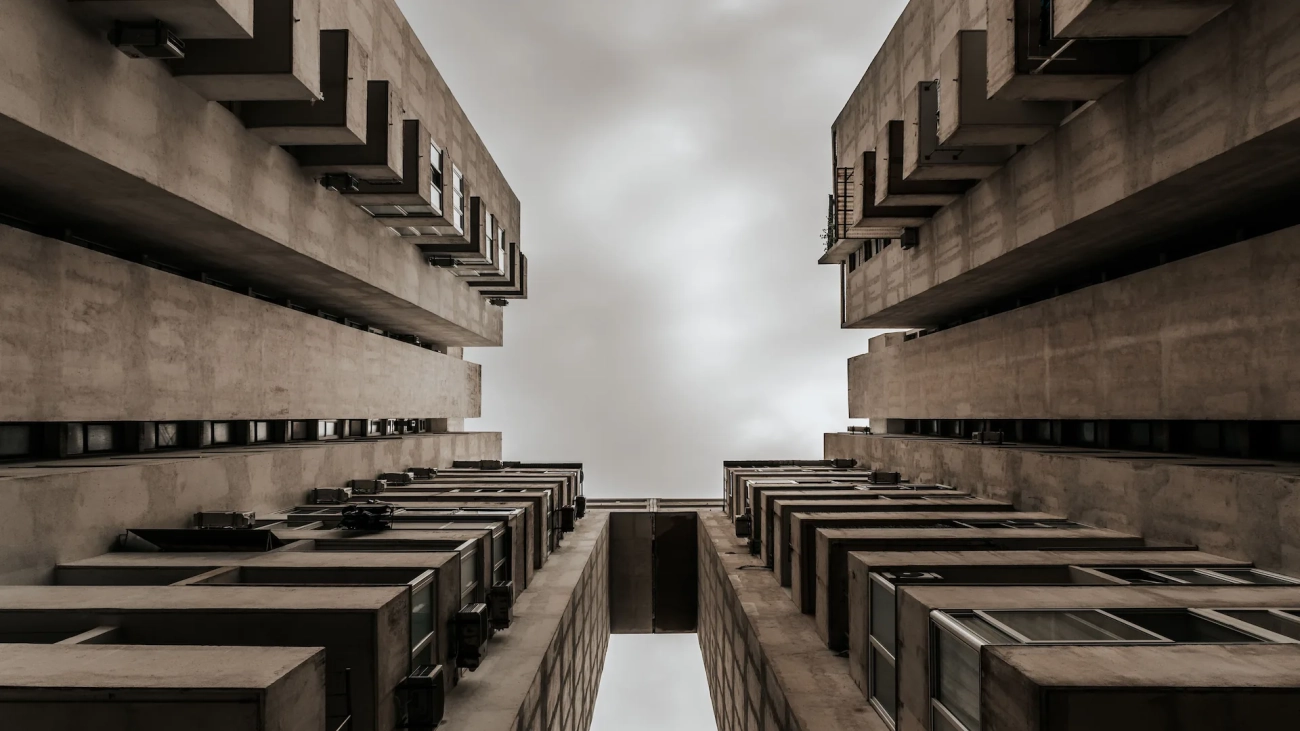Madrid is not just a city to enjoy its gastronomy, cultural life, and streets full of history. It is also a fascinating setting for architecture lovers. Beyond the classic palaces or the modern glass buildings that dot its skyline, the capital is home to true gems of brutalist architecture, a style that marked the 1960s and 1970s and still sparks debate and admiration in equal measure today.
If you’re passionate about unique tourism and love discovering the city from less conventional perspectives, join us on this journey through brutalist architecture in Madrid: its origins, its arrival in the capital, the buildings you must see, and how to recognize this distinctive urban style.
What is Brutalist Architecture and What is its Origin?
Brutalist architecture was born in the post-war period, in the mid-20th century, as a movement that sought to break away from excessive ornamentation and focus on pure forms, raw materials, and monumentality.
The term “brutalism” comes from the French “béton brut,” which means “raw concrete,” the most characteristic material of this style. Brutalist architects used exposed concrete not only for its strength and economy but also for its sober and striking aesthetics.
This movement is associated with figures like Le Corbusier, one of the great references of modern urbanism, who laid the theoretical foundations of brutalism in his work Unité d’Habitation. His influence quickly spread across Europe and America, particularly in institutional buildings, universities, and social housing, where robustness and functionality were key.
The Arrival of Brutalism in Madrid: A Style with its Own Identity
In Spain, brutalist architecture developed mostly between the 1960s and 1980s, during a period of rapid urban growth. Madrid was one of the main settings for this transformation, with buildings designed to respond to social, cultural, and educational needs.
Although brutalism was not as popular as in countries like the UK or France, the capital has notable examples that show how this style adapted to the city’s urban understanding. In many cases, it was combined with other architectural languages, resulting in unique works with their own character.
One of the most interesting aspects of Madrid’s brutalism is that it fits into a functionalist vision of architecture, where buildings were not conceived solely as aesthetic works, but as practical and useful spaces for daily life: universities, cultural centers, residential blocks, and administrative buildings.
Most Iconic Brutalist Buildings in Madrid
If you want to take a different architectural tour through Madrid, here are some of the most emblematic brutalist buildings you can’t miss.
- Torres Blancas. An emblem of modern Madrid. Paradoxically, this building is neither white nor made up of towers in the strict sense, but it is one of the most iconic examples of brutalism in Madrid. Designed by architect Sáenz de Oiza in 1969, it stands out for its cylindrical shapes and futuristic look. It is a residential building that has become a symbol of the city.
- Faculty of Information Sciences at the Complutense University of Madrid. Designed by architect José María Laguna in the 1970s, it is one of the purest examples of university brutalism in Madrid. Its imposing structure of exposed concrete, with solid volumes and horizontal windows, makes it an unmistakable building within the Ciudad Universitaria (University City). It is a significant academic and architectural reference.
- Building of the Institute of Cultural Heritage of Spain (IPCE), known as “the crown of thorns.” Designed by Fernando Higueras and Antonio Miró, this 1965 building is one of the most unique examples of brutalism in Madrid. Its circular plan, with large concrete buttresses and its almost futuristic aesthetic, has made it an architectural icon.
- Church of Our Lady of the Rosary of the Philippines. In the heart of the Prosperidad neighborhood, this church built in the 1960s combines brutalism with expressionist touches. The use of concrete, along with the sobriety of its shapes, conveys a spiritual force very characteristic of religious architecture of the time.
How to Recognize the Key Features of Brutalism in the City
You may have walked by a brutalist building in Madrid without realizing it. However, this style has very defined characteristics that make it unmistakable. Pay close attention:
- Exposed concrete as the protagonist, with no coverings or adornments, showing its rough texture.
- Solid geometric volumes, with straight or cylindrical shapes that convey strength and solidity.
- Monumental scale. These are buildings that impose themselves with their size and presence in the urban space.
- Functionality over aesthetics, where each part of the building serves a practical function, even though the result is visually striking.
- A sense of strength. Brutalist architecture often conveys security and robustness, as if the buildings are built to withstand anything.
Once you learn to recognize these features, you’ll find that Madrid is full of brutalist corners that blend naturally with the rest of the urban landscape.
The Relationship Between Brutalism and Urban Life in Madrid
Brutalism has had a special relationship with the city and its inhabitants. Although it was initially criticized for its harsh and unadorned aesthetic, today many Madrileños and visitors value it as part of the contemporary architectural heritage.
These buildings, designed with a functionalist approach, were created to improve urban life: offering spacious housing, modern educational spaces, or solid cultural infrastructures. Over time, they have become visual landmarks that remind us of the importance of innovation in each stage of the city’s history.
Moreover, the presence of brutalism in neighborhoods and university campuses has created an emotional bond with those who have lived or studied in these spaces. That blend of nostalgia and modernity makes Madrid’s brutalism more than just an architectural style: it is a reflection of how the city has evolved while preserving its essence.
Brutalist architecture in Madrid invites us to look at the city with fresh eyes. Far from the usual tourist clichés, this style reveals an innovative, bold, and contrast-filled Madrid. From the imposing Torres Blancas to the university buildings, brutalism continues to remind us that architecture is also a form of urban art.
Book Now on BizTrip

